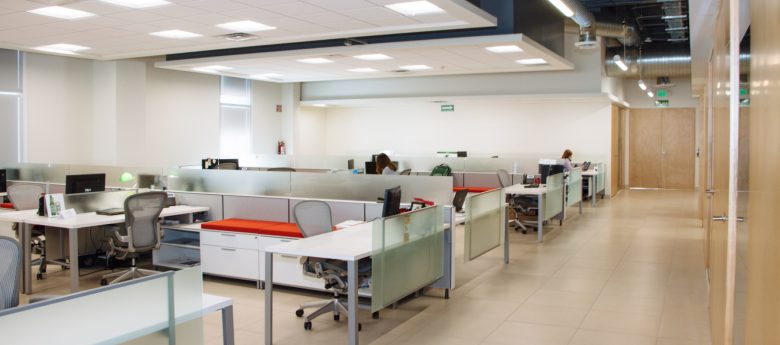What Flexible Office Space Means for Facility Management

Flexible office spaces are contemporary workspaces designed to accommodate the dynamic business needs of different companies while availing a mix of communal and private work areas. Unlike traditional office spaces, several organizations share the same building and access shared information technology (IT) infrastructure, office furniture, conference rooms, and ready-to-use office equipment. Workers in a flexible office space can readily plug in and begin working on different projects without worrying over setup and service charge costs.
The demand for flexible office spaces is rising as companies find ways to reduce operational costs, increase employee productivity, adjust to socio-economic disruptions (like the Covid-19 pandemic), and mitigate skilled labor shortages. Organizations globally are welcoming the idea of remote work and shared workplaces to meet business goals and remain competitive. Flexible office space accommodates professionals at all levels. A single office block can be home to freelancers, business executives, startup founders, and consultants.
There are several types of flexible office spaces to meet the needs of different businesses and workers. They include:
- Coworking spaces
- Serviced offices
- Hybrid offices
Shifting operations to flexible office spaces enables companies to control occupancy costs, minimize environmental impact, set up operations faster, increase networking opportunities, and enhance employee productivity. Companies can scale operations sustainably, depending on the prevailing market dynamics.
What are the impacts of flexible office spaces on facility management, and how should managers respond to changing work patterns?
Flexible Office Spaces Are Here To Stay
Companies and independent contractors are including flexible office spaces as part of their long-term business strategies. The modern workforce prefers flexible spaces with the latest technological integrations and adequate amenities that guarantee personalized work experiences. The pandemic season also changed the global work perspective, with several companies engaging in a hybrid workforce. The trend is not likely to change since organizations enjoy better productivity and can retain talent by allowing them to work in flexible office spaces.
The pandemic and political tensions presented several challenges to business owners around the world. Businesses must proactively adjust operations to adapt to changing market dynamics. Flexible office spaces allow companies to expand or contract the workforce without interrupting routine workflows. Moving forward, more organizations are likely to ditch traditional offices in favor of flex offices. Companies treat facilities lacking flexible office spaces as an impediment to their business goals.
Flexible office space enables companies to reduce their operational costs sustainably. The looming workforce uncertainties mean companies cannot commit to long-term leases and fixed office locations. Instead, these companies pay for office spaces in different places, depending on the headcounts and the available office budgets.
Real-estate companies utilize these market trends to customize flexible office designs and realign business goals. There is increased utilization of advanced technology for facilities management, marketing, and demand planning.
Mitigating the Impacts of Flexible Office Space
The occupancy of flexible office spaces varies over time, with different numbers of employees and clients visiting the office daily. Unlike traditional office space, it may be hard to estimate daily building occupancy. The higher occupancy densities associated with flexible office space exert additional pressure on amenities and resources like elevators, heating, ventilation, air conditioning (HVAC) units, building systems, and energy consumption.
Facility managers must establish measures to control occupancy density to minimize pressure on these resources. For instance, managers can dictate the maximum number of personnel allowed to occupy open spaces at a particular time. That way, they can manage the operation of HVAC systems that control indoor air quality for optimum wellness within offices.
Facility managers can also automate building access to secure premises. The managers should optimize soundproofing in offices to ensure everyone gains value for their money. Facility management companies should proactively adjust resources to reflect the increasing occupancy. They must provide enough facility safety features like fire exits, firefighting equipment, and alarm response systems.
Operational and Management Strategies for Accommodating Diverse Work Styles
Managing flexible office space has several challenges. It defies norms associated with traditional office management. Operating a flexible office space is capital-intensive, and facility owners must customize experiences depending on the existing clients. The manager has to strike a balance between short and long-term leases while implementing low-risk asset management strategies.
Facility owners enter into management agreements with third-party facility management companies that handle daily operations. It allows owners to minimize lease liabilities and enjoy better profit margins. Third-party management companies leverage the latest technologies to manage clientele, maintenance tasks, bookings, and routine housekeeping tasks.
The management companies customize occupant experiences by researching the latest flex space trends and encouraging diversity in facilities instead of the one-size-fits-all management style popular with traditional offices.
Flexible office space continues to evolve rapidly. Property owners must remain vigilant, exploiting the shortcomings of existing facility management strategies to expand their businesses and increase revenues. Property owners can enlist the services of experienced facility management firms to design flexible office spaces and mitigate potential impacts of increased office occupancy. Facility management firms should leverage technology to enhance office sustainability, cater to dynamic tenant demands, and foster productivity among hybrid workforces.
Bryan Christiansen is the founder and CEO of Limble CMMS. Limble is a modern, easy-to-use mobile CMMS software that takes the stress and chaos out of maintenance by helping managers organize, automate, and streamline their maintenance operations.
